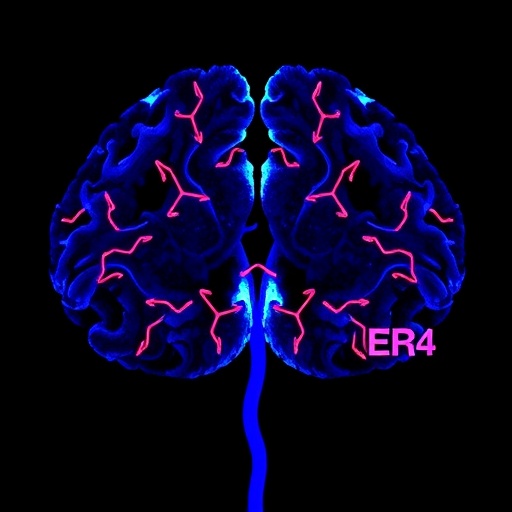Emerging research in the field of neurodegeneration has illuminated the complexities surrounding Alzheimer’s disease (AD), a condition that hinders cognitive function and disrupts lives worldwide. Among the latest findings, a study led by Demetriou et al. investigates the role of estrogen receptors, specifically estrogen receptor beta (ERβ), in mediating sex-specific protective mechanisms against Alzheimer’s in a genetically modified mouse model known as App-NL-G-F. This research marks a pivotal step that could lead to tailored therapeutic approaches in treating Alzheimer’s, a disease whose prevalence continues to escalate in an aging population.
The App-NL-G-F mouse model represents a sophisticated tool for studying the pathophysiological aspects of Alzheimer’s disease. Engineered to mimic the amyloid plaque deposition observed in human patients, this model allows researchers to scrutinize the intricate mechanisms underlying neurodegeneration. In this context, the role of ERβ, a receptor that binds estrogen, emerges as a critical factor. Notably, the expression of this receptor has been linked to various neuroprotective effects, potentially shedding light on sex differences in the onset and progression of Alzheimer’s disease.
Demetriou and colleagues conducted a comprehensive investigation to discern how ERβ contributes to cognitive function within the App-NL-G-F mouse model. They delineated the behavioral and cognitive assessments that indicated sex-specific differences in memory and learning capabilities. Significantly, female mice demonstrated enhanced cognitive resilience, presumably due to the beneficial actions of ERβ. The implication here is profound, suggesting that estrogen’s neuroprotective mechanisms may vary between genders, paving the way for gender-specific therapeutic interventions.
Delving deeper into the biological implications of their findings, the authors outlined how ERβ mediates neuroprotection. Estrogen has long been recognized for its involvement in synaptic plasticity—an essential process necessary for learning and memory formation. This study underscored that ERβ influences synaptic strength and promotes neuronal health, ensuring that the neurons remain functional and capable of forming new connections. As a crucial mediator, ERβ recognizes estrogen and activates a cascade of downstream signaling pathways that ultimately converge to enhance cognitive functions.
The findings also prompt a reconsideration of hormone replacement therapies in clinical settings. With current discussions surrounding the efficacy of estrogen replacement for postmenopausal women, the research provides valuable insights. It suggests that therapies targeting ERβ specifically could yield significant neuroprotective benefits, thereby ameliorating symptoms or even delaying the onset of Alzheimer’s in susceptible populations.
Moreover, the investigation provides evidence of the differential expression of ERβ in male and female brains, adding a layer of complexity to our understanding of AD. The study indicated that female mice had a more pronounced expression of the ERβ at critical stages of their development, thereby boosting their capacity for cognitive resilience against pathological changes. This sex-specific expression pattern raises essential questions about the timing and administration of estrogen-based therapies in various demographic groups.
The implications of these findings extend beyond mere academic curiosity. Alzheimer’s disease is not only a medical concern but also a socio-economic challenge that imposes a heavy burden on families and healthcare systems. If the protective effects of ERβ can be effectively harnessed, it opens the door to novel therapeutic strategies aimed at lessening the cognitive decline associated with Alzheimer’s disease.
Crucially, the study advocates for more expansive research to explore ERβ’s multifaceted roles within the central nervous system. Understanding how various lifestyle factors, such as diet and exercise, interact with hormonal signaling could provide further insights into the prevention and treatment of Alzheimer’s. Lifestyle modifications that promote estrogen’s protective effects could significantly shape therapeutic regimens in the future.
Furthermore, the study underscores the necessity for personalized medicine in the realm of neurodegenerative diseases. Given the nuances associated with sex differences and neurobiology, a one-size-fits-all approach to Alzheimer’s treatment may be inadequate. Tailoring interventions based on an individual’s gender and hormonal status could enhance the effectiveness of therapeutic strategies, as highlighted poignantly by the results from the App-NL-G-F mouse model.
As the research landscape around Alzheimer’s disease continues to evolve, the emphasis on sex differences becomes increasingly paramount. The work of Demetriou et al. serves as a clarion call for further research into the hormonal and genetic factors that influence neurodegeneration. Such efforts could culminate in groundbreaking therapies that not only delay onset but also improve the quality of life for millions affected by Alzheimer’s disease.
In summary, the exploration of ERβ and its protective capabilities against Alzheimer’s in the App-NL-G-F mouse model represents a critical juncture in understanding gender-specific risk factors. The convergence of neurobiology, sex differences, and personalized medicine reiterates the complexity of Alzheimer’s disease and the urgent need for continued investigation into its underlying mechanisms. As we forge ahead, it is imperative that the scientific and medical communities adopt an integrative approach that considers these critical variables, ensuring that we effectively combat this debilitating disease.
The journey to uncover the nuanced relationship between hormones and Alzheimer’s disease is just beginning, but research like this promises to shine a light on previously unexplored territories. By understanding the biological interplay of sex, hormones, and neurodegenerative processes, we can strive toward a future where Alzheimer’s is no longer a formidable adversary, but rather a manageable condition.
Subject of Research: The role of estrogen receptor beta (ERβ) in sex-specific protection against Alzheimer’s disease in a mouse model.
Article Title: ERβ mediates sex-specific protection in the App-NL-G-F mouse model of Alzheimer’s disease.
Article References:
Demetriou, A., Lindqvist, B., Ali, H.G. et al. ERβ mediates sex-specific protection in the App-NL-G-F mouse model of Alzheimer’s disease.
Biol Sex Differ 16, 29 (2025). https://doi.org/10.1186/s13293-025-00711-w
Image Credits: AI Generated
DOI: 10.1186/s13293-025-00711-w
Keywords: Alzheimer’s disease, estrogen receptor beta, neuroprotection, sex differences, mouse model




